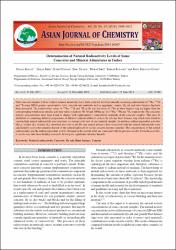Determination of natural radioactivity levels of some concretes and mineral admixtures in Turkey

Göster/
Erişim
info:eu-repo/semantics/openAccessTarih
2014Yazar
Baltaş, HasanKiriş, Erkan
Ustabaş, İlker
Yılmaz, Esra
Şirin, Murat
Kuloğlu, Emrah
Güneş, Banu Erdoğan
Üst veri
Tüm öğe kaydını gösterKünye
Baltas, H., Kiris, E., Ustabas, I., Yilmaz, E., Sirin, M., Kuloglu, M., Gunes, B.E., (2014).Determination of Natural Radioactivity Levels of Some Concretes and Mineral Admixtures in Turkey.Asian Journal of Chemistry, 26(13), 3946-3952.https://doi.org/10.14233/ajchem.2014.16045Özet
Nine concrete samples with or without mineral admixtures have been analyzed for their naturally occurring radionuclide of Ra-226, Th-232 and K-40 using HPGe gamma spectrometry. Also, concrete raw materials such as aggregate, cement, fly ash and blast furnace slag have been measured. the radioactivity values of Ra-226, Th-232 and K-40 in fly ash and those of Ra-226 in blast furnace slag are higher than the corresponding world mean specific activities values which are 50, 50 and 500 Bq kg(-1) for Ra-226, Th-232 and K-40, respectively. the concretes activity concentrations have been found to change with supplementary cementitious materials of the concrete samples. This may be attributed to containing different proportions of different mineral additives such as fly ash and blast furnace slag which were found to contain high natural radionuclide concentrations according to the rest of raw material samples. in addition, radium equivalent activities (Ra-eq), gamma-index (I-gamma), alpha-index (I alpha), absorbed dose rate in air (D) and annual effective dose associated with the natural radionuclide were calculated to assess the radiation hazard of the natural radioactivity in the concrete mixture samples. the concentration of the natural radionuclides and the radium equivalent activity obtained in the present study are compared with the previous results. From these results, it can be seen that these building materials do not pose significant radiation hazards.

















